Helena
Sand & Gravel
Now
Spring Meadow Lake

CLICK
ON PHOTO FOR A LARGE VERSION IN A NEW WINDOW
|
Helena
Sand and Gravel had its beginnings in 1929, partially
a result of the catastrophic 1928 downtown Helena
fire. George Jacoby, son of Charles Jacoby (a 2nd
generation contractor, Frank Jacoby and Son) saw the
need for clean aggregates for construction and railroad
ballast in Montana. He bought 36 acres of tax title
gravel land two miles west of Helena, which included
the old stone John Stedman Foundry and Machine Company
buildings, and utilized the Jacoby Speeder shovel
(used in the reconstruction of downtown) to dig for
gravel. The resulting pit opened up underground springs,
and it soon became an expanding lake.
Helena
Sand and Gravel also delivered ready-mixed concrete,
and were involved in large building projects in the
Helena area. In 1951 Jacoby got into the street paving
business with the addition of an Amalga-Pave cold
mix asphalt facility.
Jacoby
retired in 1955, selling the business to W.A. "Bill"
Carson who further carved out the channels and islands
of the lake. Carson died in 1964, by which time the
gravel had run out. A real estate developer planned
to build condos on the site, and called it “Spring
Meadow”, but the project was never carried out.
In
the early 1980s the State of Montana purchased the
property for a State
Park. Remnants of the old Helena Sand and Gravel
plant, and the earlier Stedman Foundry - the future
home of the Montana
Wildlife Center - can still be seen.
These
beautiful photographs are from the collection of artist
and graphic designer Kathryn
Fehlig, granddaughter of George Jacoby. Many thanks
to Kathy for sharing these wonderful images!
|
Jacoby
Family, circa 1922

|
A
Jacoby family portrait taken near Lincoln, Montana.
Left to right: Charles Jacoby, Frank Jacoby, Dorothy
Ann Jacoby, and George Jacoby.
Frank Jacoby was the pioneer, arriving in Helena before
1878. He was a carpenter and formed a company with
his son, Charles, called "Frank Jacoby and Son."
In 1915 Charles formed a partnership with his brother
Frank under the same name. George Jacoby worked for
the firm until forming his own business, Helena Snad
& Gravel, in 1929.
Frank
Jacoby and Son built many buildings in Helena during
the first half of the 20th century,
including St. Johns Hospital, the YWCA, the old Western
Life building, Shodair Hospital, Colorado Building,
LaLonde Block, Granite Block, 7th Avenue Gym, and
Carroll College.
|

This
first series of photos was taken in 1929, and show the machinery
involved in the process...

| Pictured
is George Jacoby opening the pit in August of 1929.
The Speed Shovel loads a 4 cubic-yard rolling skip.. |
Overview
of the Operation, August 1929

|
At the center left is seen the Speed Shovel and the
skip. The loaded skip was pulled up the tracks by an
electric hoist housed in the structure with the sloping
roof. Once at the top, the contents of the skip was
automatically dumped through a grating made of railroad
rails set ten inches apart (called a "grizzley"). |
The
Skip Discharging Material Through the Grizzley
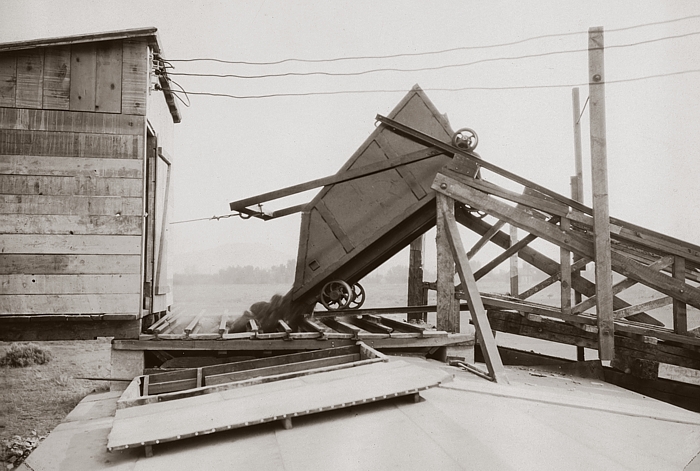
| The
grizzley screened out the very largest stones. The electric
hoist is housed in the wooden structure. |
Telsmith
Plate Feeder

| The
next step for the material was a trip through this 24½"
x 5´ Telsmith Plate Feeder, a three foot by five
foot wedge bar grizzley further separated the stones
from the gravel. We also see the top of the 10-A primary
breaker. |
10-A
Primary Breaker

| A
view of the 10-A primary breaker, and the start of the
20 inch belt conveyor. The breaker and feeder were driven
by 40 hp Westinghouse Electric Motor. |
View
from the Hoist, 1929

|
View
from the hoist, showing material traveling up the
20-inch conveyor belt to the washer. At the right
is the six-inch water pipe running from the pump house
to the washer. In the background on the right can
be seen the first Kessler School building, which was
damaged in the 1935 earthquakes and subsequently demolished.
|
Ajax
Gravel Washer

| The
40 inch by 18 foot Ajax Gravel Washer, seen from the
discharge end. It was propelled by a 25 hp motor, which
also drove the 20 inch belt conveyor. |
Reduction
Crusher
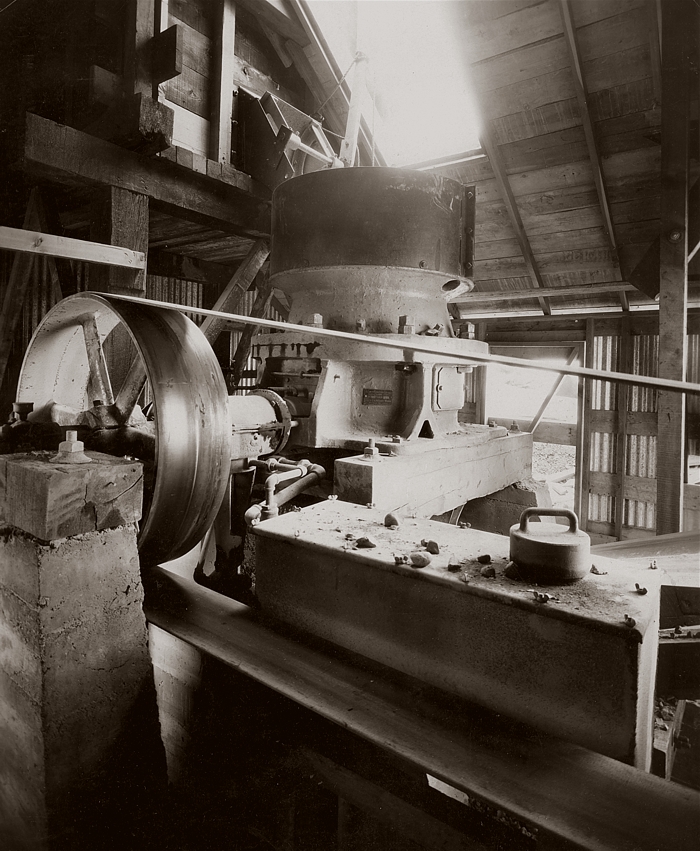
Side
view of the reduction crusher, which was propelled by
30 hp motor, which also drove the 16-inch belt conveyor
which discharged onto the 20 inch belt, taking the product
ofthe reduction crusher. |
View
of Helena Sand & Gravel, 1929

CLICK
ON PHOTO FOR A LARGE VERSION IN A NEW WINDOW
August
1 1929


The following images are from 1936-1951, and show the growth
of Helena Sand & Gravel

|
Looking
eastward at the operation in 1936. The underground
springs had been uncovered.
CLICK
ON PHOTO FOR A LARGE VERSION IN A NEW WINDOW
|
Aerial
View of Helena Sand & Gravel, 1940s

CLICK
ON PHOTO FOR A LARGE VERSION IN A NEW WINDOW
The
Helena Sand & Gravel Office, Late 1940s

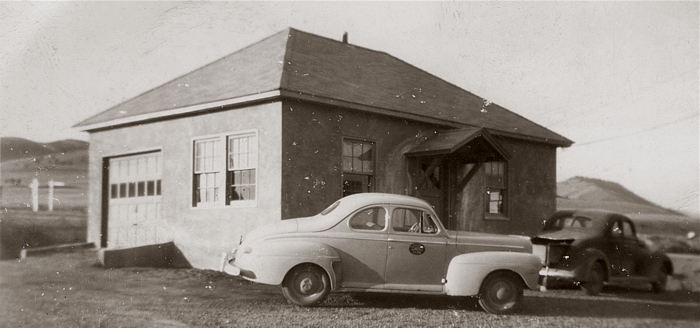
Helena
Sand & Gravel Office Interior

The
men are unidentified, but the dog is "Major".
The
Pump House, January 10, 1939

Old
Stedman Foundry buildings, date unknown
 .
.
The
Dragline

The
Sauerman Bros. dragline bin and mast, probably 1946.
Sauerman
Dragline Slack-line Cable

Dragline
in Operation, 1947
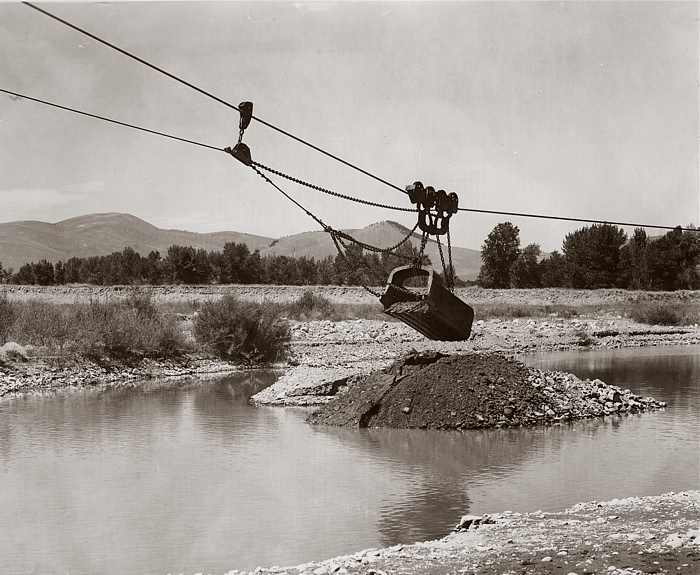

Helena
Sand & Gravel Fleet, May 13 1948

CLICK
ON PHOTO FOR A LARGE VERSION IN A NEW WINDOW
| The
drivers, from left to right: Tom Plovanich, George Heller,
S.L. White, A.C. Storlie, E.J. Kenda. |
Ready-Mixed
Concrete Plant, About 1952

Amalga-Pave
Plant, About 1952

View
of the Plant, August 1 1951

CLICK
ON PHOTO FOR A BIG VIEW IN A NEW WINDOW
Eugene
Fehlig (left) and George Heller

|
George Jacoby's only child, Dorothy Ann, married Gene
Fehlig in 1943. In 1945, Gene joined George in the gravel
business and worked there until 1954, when he moved
his family back to his home town of St. Louis, Missouri.
|
Helena
Sand & Gravel Company Picnic on MacDonald Pass, Aug.
6 1955
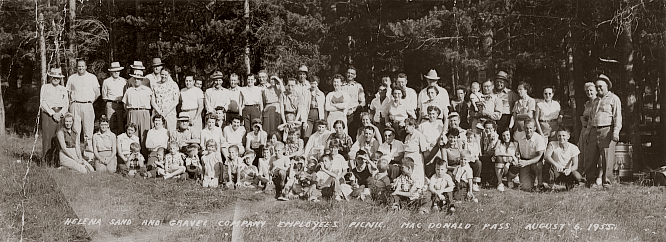
CLICK
ON IMAGE FOR A BIG VIEW IN A NEW WINDOW




















 .
.







